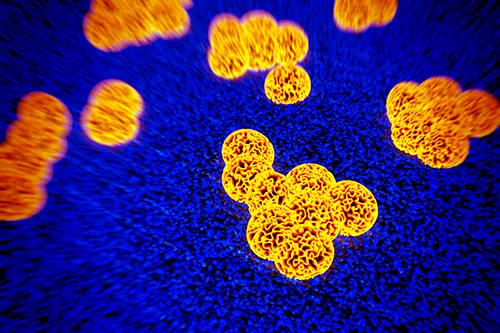
Unraveling MRSA: The Superbug's Double Defense Against Antibiotics Revealed!
2024-11-01
Author: Mei
Groundbreaking Research from the University of Sheffield
Recent groundbreaking research from the University of Sheffield has shed light on the formidable survival strategies of methicillin-resistant Staphylococcus aureus (MRSA). This notorious superbug has developed a clever two-fold defense mechanism that allows it to withstand the onslaught of high-level antibiotics. The detailed findings of this pivotal study are published in the esteemed journal, Science, under the title “Two codependent routes lead to high-level MRSA.”
Understanding MRSA's Resistance Mechanisms
Historically, it was understood that MRSA developed its resistance through the acquisition of a newly adapted cell wall enzyme. However, the Sheffield researchers have discovered that this adaptation alone falls short of ensuring its survival amidst antibiotic exposure. Their investigation revealed that MRSA also utilizes an alternative cell division mechanism that enables it to replicate even in the presence of these powerful drugs.
Significance of the Findings
Dr. Simon Foster, one of the lead researchers and chair of microbiology at the University of Sheffield's School of Biosciences, emphasized the significance of these findings. "These revelations have critical implications not only for the development of novel antibiotics but also for comprehending the fundamental processes of bacterial growth and division. This insight will open doors to innovative strategies for combating this dangerous pathogen."
Advanced Research Techniques
Using advanced techniques like atomic force microscopy, the researchers meticulously examined how antibiotics disrupt the architecture of the cell wall's peptidoglycan at the division septum, which ordinarily prevents cell replication. They found that MRSA has adapted to utilize an alternative cell division mode, altering its peptidoglycan structure at these crucial points. This newfound adaptability also associates with specific chromosomal mutations, which may act as potentiators in MRSA’s resistance.
Future Research Directions
Looking ahead, the research team aims to delve deeper into how MRSA utilizes this unique growth and division strategy in antibiotic environments. The next phase includes identifying inhibitors that can specifically target these new survival tactics, potentially leading to the next generation of effective treatments against MRSA.
Interdisciplinary Approaches in Research
Dr. Jamie Hobbs, a professor of physics at the University of Sheffield, highlighted the importance of interdisciplinary approaches in this research. "This study is an exemplary demonstration of how the fusion of physics and biology can confront the urgent challenge of antimicrobial resistance. It showcases the impact of combining advanced microscopy with genetics and microbiology."
Implications of the Research
As the threat of antibiotic resistance looms larger, this research signifies a crucial step forward. The understanding of MRSA's dual defense system could be pivotal in developing strategies to outsmart these resilient bacteria, ultimately saving lives and aiding global health initiatives. Stay tuned for more updates as researchers continue to battle the ever-evolving world of superbugs!

 Brasil (PT)
Brasil (PT)
 Canada (EN)
Canada (EN)
 Chile (ES)
Chile (ES)
 España (ES)
España (ES)
 France (FR)
France (FR)
 Hong Kong (EN)
Hong Kong (EN)
 Italia (IT)
Italia (IT)
 日本 (JA)
日本 (JA)
 Magyarország (HU)
Magyarország (HU)
 Norge (NO)
Norge (NO)
 Polska (PL)
Polska (PL)
 Schweiz (DE)
Schweiz (DE)
 Singapore (EN)
Singapore (EN)
 Sverige (SV)
Sverige (SV)
 Suomi (FI)
Suomi (FI)
 Türkiye (TR)
Türkiye (TR)